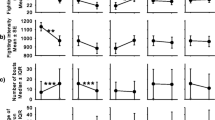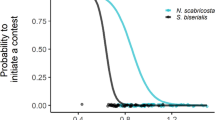Abstract
The effect of resource-holding power (RHP) and prior residency asymmetries on fight outcome and subsequent seasonal copulatory success was analyzed for fights between marked male northern elephant seals (Mirounga angustirostris). RHP asymmetries were measured as differences in estimated mass and prior residency asymmetries were measured as differences in beach tenure prior to the fight. The principal results were: (a) Neither differences in mass nor differences in beach tenure had any effect on fight outcome as separate factors. (b) Mass and tenure differences had an interactive effect on fight outcome; fight winners were either heavier males present for shorter periods (intruders) or lighter males present for longer periods (prior residents). (c) Winners of fights copulated more often than losers after a fight throughout the breeding season; this difference was smallest for low-ranking males, larger for high-ranking males in short fights, and greatest for high-ranking males in long fights. (d) Prior resident males who won long fights obtained significantly more copulations after a fight than the males they defeated, but this was not true for intruder males who won long fights. These results suggest that male northern elephant seals will incur greater contest costs (i.e., fight for longer periods and/or against heavier males) for higher reproductive payoffs. They also imply that, at least for males in long fights, differences in prior residence represent payoff asymmetries, with higher reproductive payoffs for winning prior residents than for winning intruders.
Similar content being viewed by others
References
Austad SN (1983) A game theoretical interpretation of male combat in the bowl and doily spider (Frontinella pyramitela). Anim behav 31:59–73
Boyd R, Silk JB (1983) A method for assigning cardinal dominance ranks. Anim Behav 31:45–58
Clinton WL (1990) Sexual selection and the life history of male northern elephant seals. Ph.D. thesis, University of California, Santa Cruz
Clinton WL, Le Boeuf BJ (1993) Sexual selection's effects on male life history and the pattern of male mortality. Ecology 74:1884–1892
Clutton-Brock TH, Albon SD, Gibson RM, Guinness FE (1979) The logical stag: adaptive aspects of fighting in red deer (Cervus elaphus L.). Anim Behav 27:211–225
Davies NB (1978) Territorial defence in the speckled wood butterfly (Pararge aegeria).: the resident always wins. Anim Behav 26:138–147
Deutsch CJ (1990) Behavioral and energetic aspects of reproductive effort in male northern elephant seals (Mirounga angustirostris). Ph.D. thesis, University of California, Santa Cruz
Deutsch CJ, Haley MP, Le Boeuf BJ (1990) Reproductive effort of male northern elephant seals: estimates from mass loss. Can J Zool 68: 2580–2593
Deutsch CJ, Crocker DE, Costa DP, Le Boeuf BJ (in press) Sex- and age-related variation in reproductive effort of northern elephant seals. In: Le Boeuf BJ, Laws RM (ed) Elephant seals: population ecology, behavior and physiology. University of California Press, Berkeley
Dugatkin LA, Ohlsen SR (1990) Contrasting asymmetries in value expectation and resource holding power: effects on attack behaviour and dominance in the pumpkinseed sunfish, Lepomis gibbosus. Anim Behav 39:802–804
Englund G, Olsson TI (1990) Fighting and assessment in the net spinning caddis larva Artopysche ladogensis: a test of the sequential assessment game. Anim Behav 39:55–62
Enquist M, Leimar O (1983) Evolution of fighting behaviour: decision rules and assessment of relative strength. J Theor Biol 102:387–410
Enquist M, Leimar O (1987) Evolution of fighting behaviour: the effect of variation in resource value. J Theor Biol 127:187–205
Enquist M, Leimar O (1990) The evolution of fatal fighting. Anim Behav 39:1–9
Enquist M, Leimar O, Ljundberg T, Mallner Y, Segerdahl N (1990) A test of the sequential assessment game: fighting in the cichlid fish Nannacarra anomala. Anim Behav 40:1–14
Grafen A (1987) The logic of divisively asymmetric contests: respect for ownership and the desperado effect. Anim Behav 35:462–467
Haley MP (1990) Fighting and dominance in male northern elephant seals. Ph.D. thesis, University of California, Santa Cruz
Haley MP, Deutsch CJ, Le Boeuf BJ (1991) A method for estimating the mass of large pinnipeds. Mar Mammal Sci 7:157–164
Haley MP, Deutsch CJ, Le Boeuf BJ (in press) Size, dominance and copulatory success in male northern elephant seals, Mirounga angustirostris. Anim Behav, in press
Hammerstein P (1981) The role of asymmetries in animal contests. J Theor Biol 29:193–205
Hammerstein P, Parker GA (1982) The asymmetric war of attrition. J Theor Biol 96:647–682
Holberton RL, Hanano R, Able KP (1990) Age-related dominance in male dark-eyed juncos: effects of plumage and prior residence. Anim Behav 40:573–579
Leimar O, Enquist M (1984) Effects of asymmetries in owner-intruder conflicts. J Theor Biol 111:475–491
Le Boeuf BJ (1972) Sexual behavior in the northern elephant seal, Mirounga angustirostris. Behaviour 41:1–26
Le Boeuf BJ (1974) Male-male competition and reproductive success in elephant seals. Am Zool 14:163–176
Le Boeuf BJ, Peterson RS (1969) Social status and mating activity in elephant seals. Science 163:91–93
Le Boeuf BJ, Reiter J (1988) Lifetime reproductive success in northern elephant seals. In: Clutton-Brock T (ed) Reproductive success. University of Chicago Press, Chicago, pp 344–362
Le Boeuf BJ, Whiting RJ, Gantt RF (1972) Perinatal behavior of northern elephant seals and their young. Behaviour 43:121–156
Marden JH, Waage JK (1990) Escalated damselfly territorial contests are energetic wars of attrition. Anim Behav 39:954–959
Maynard Smith J (1974) The theory of games and the logic of animal contests. J Theor Biol 47:209–221
Maynard Smith J, Parker GA (1976) The logic of asymmetric contests. Anim Behav 24:159–175
Parker GA (1974) Assessment strategy and the evolution of fighting behavior. J Theor Biol 47:223–243
Parker GA, Rubenstein DI (1981) Role assessment, reserve strategy, and acquisition of information in asymmetric animal conflicts. Anim Behav 29:221–240
Rice WR (1990) A consensus combined P-value test and the family-wide significance of component tests. Biometrics 46:303–308
Riechert SE (1979) Games spiders play: II. Resource assessment strategies. Behav Ecol Sociobiol 6:121–128
Shipley C, Hines M, Buchwald J (1981) Individual differences in threat calls of northern elephant seals bulls. Anim Behav 29:12–19
Sigursjøndottir H, Parker GA (1981) Dung-fly struggles: evidence for assessment strategy. Behav Ecol Sociobiol 8:219–230
Verrell PA (1986) Wrestling in the red-spotted newt (Notophthalmus viridescens): resource value and contestant asymmetry determine contest duration and outcome. Anim Behav 34:398–402
Wells MS (1988) Effect of body size and resource value on fighting behaviour in a jumping spider. Anim Behav 36: 321–326
Author information
Authors and Affiliations
Rights and permissions
About this article
Cite this article
Haley, M.P. Resource-holding power asymmetries, the prior residence effect, and reproductive payoffs in male northern elephant seal fights. Behav Ecol Sociobiol 34, 427–434 (1994). https://doi.org/10.1007/BF00167334
Received:
Accepted:
Issue Date:
DOI: https://doi.org/10.1007/BF00167334




